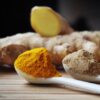What’s hiding in your healthy food.
If you’re part of the new wave of supermarket savvy shoppers, you will be choosing to buy healthy and unprocessed foods. You still buy packaged foods but know how to read labels and what to watch out for. You’ve probably noticed that many of the additives and ingredients that you’ve been carefully avoiding are becoming less common.
Does this mean manufacturers are cleaning up their act? Listening to the consumer dollar and making changes for the good of our health? Yes. And No. There are companies who have made their products better and replaced ingredients with better ones that are less problematic. But we can’t assume that’s always the case.
You see there’s been a shift in the manufacturing mind. They’re learning how to rewrite labels to make them ‘clean’. To take away the chemical names and replace them with more normal and natural sounding ones. 
Because in case you haven’t noticed, keeping things natural is very appealing today.
Undercover
Early last year the London Guardian wrote about an undercover adventure at Frankfurt’s Festhalle Messe. It was 2013 and manufacturers were proudly showing off their latest technological wizardry.
There is NatureSeal which adds 21 days to fruit and vegetables shelf life. Glucono-Delta-Lactone that prolongs the shelf life of feta cheese. Potato protein isolate to makes cakes without eggs, butter or cream. Butter Buds® to give a butter flavour that has as much as 400 times the flavour intensity of butter. Microlys®, a starch to give a shiny smooth appearance. Pulpiz™ based on modified starch to give the same look as an all-tomato sauce, while using 25% less tomato paste. Mature cheese can be made by adding enzymes to young cheese to intensify the flavour, so that cheese has a mature taste in days instead of months.
Sneaky food additives
But you won’t know about them. They’re not written on your labels. They’re classed as a processing aid, not an ingredient, so there is no need to put it on the ingredient list.
This was news to me. But what’s worse, is that they have been around for a while already. Over recent years they have been introduced into our foods slowly. According to undercover agent Joanna Blythman…. There are 6000 food additives- flavourings, glazing agents, improvers, bleaching agents and more that are being used behind the scenes. Some of them new, but some of them are simply being given a new squeaky-clean image.
One of these is Rosemary Extract, which I’ve been seeing in processed foods such as corned beef and sausages. Yet how close is that Rosemary Extract to the green fragrant herb we know? A lot of chemical extraction has happened before it’s use, so that you’re not really ending up with Rosemary, but some altered form of it. It’s unknown yet what effect that final product has on us.
MSG, flavour enhancers and your moods
This sounds a lot like that other sneaky trick; labeling something as MSG free but still using high amounts of yeast extract. Yeast extract has a high concentration of the amino acid glutamate, from which monosodium glutamate ( MSG) is made. If you eat foods that naturally have glutamates, your body and brain uses it for better focus and alertness. When you eat an extracted form of it, the end result is an intense hit to the brain that translates to irritability, insomnia , hyperactivity and rashes. Basically the brain has been over stimulated.
Here are some of the other new code words you’ll find around.
Code Words
Soluble fibre
Just modified starch, which is widely used to reduce the quantity of more nutritious ingredients in processed foods, and keep down manufacturers’ costs. Modified starch (1422 or E1422), starts off as a simple starch that is chemically altered to increase its tolerance to the physical pressures of industrial-scale processing
Enzymes
Used to make bread stay soft longer; injected into low-value livestock before slaughter, to tenderise their meat; and used in fruit juice processing to create a cloudier, more natural appearance.
‘Packaged in a protective atmosphere’
Food that has been “gassed” in modified air to extend its shelf life.
Beef/pork/poultry protein
Collagen extracted from carcasses, processed into a powder and added to low-grade meats. It adds bounce, increases the protein content on the nutrition label and, combined with water, is a substitute for meat.
Washed and ready-to-eat salads
“Cleaned” by sloshing around in tap water dosed with chlorine, often with powdered or liquid fruit acids to inhibit bacterial growth. The same tank of treated water is often used for 8 hours at a time.
‘Pure’ vegetable oil
Industrially refined, bleached, deodorised oils. Commonly has other chemicals added such as synthetic antioxidants to extend the life of the oil.
‘Natural’ flavourings
Even the flavour industry concedes that “there isn’t much difference in the chemical compositions of natural and artificial flavourings”. They are made using the same physical, enzymatic, and microbiological processes.
‘Natural’ colourings
Not always so natural. They may start out with natural pigments but then go through highly chemical industrial processes to get to the end product.
Carrageenan (407 or E407)
A setting agent derived from seaweed that has been known to cause digestive upset. More so in those with IBS symptoms.
Where to now?
Should you avoid every single additive you find? In an ideal world you eat everything fresh and make everything from scratch. But this doesn’t mean you are failing yourself or your kids if you eat things out of a packet or partly ready-made. It’s about making choices on what’s important to you.
In my family I need to be mindful about synthetic antioxidants, the flavour enhancers, MSG and nitrates because they have a direct effect on some of my family. I prefer to avoid artificial colours and flavours because although they don’t seem to have an immediate effect on behaviour or health, they do seem to build up and cause problems. Yet I am fine with using products with natural colours and flavours as they don’t cause problems. For us. Some families do still find these are a problem. You can find out why in my new online course Food Additives to Avoid (link)
We rarely eat foods that have carrageenan, but I don’t actively avoid it, because it is not an issue. Again, for us. I only buy good quality oil (oils that are ‘single’ oils such as avocado or sunflower or cold pressed olive oil) but will never, NEVER buy any old vegetable oil which is a mix of who-knows-what. Because I know that cheap junky oils destroy the health of my cell’s layers, particularly in the brain. I’d like to have a strong brain as I get older, thankyou very much.
These are decisions you will need to make too.
Food Additives to Avoid Mini Course
To help you out with those shopping decisions, sign up for the new online series on food additives and reading labels. It’s part of what we do on supermarket tours too in my local area. But just in case you don’t feel like making the drive just to be with me, now you have videos to watch at home instead.





